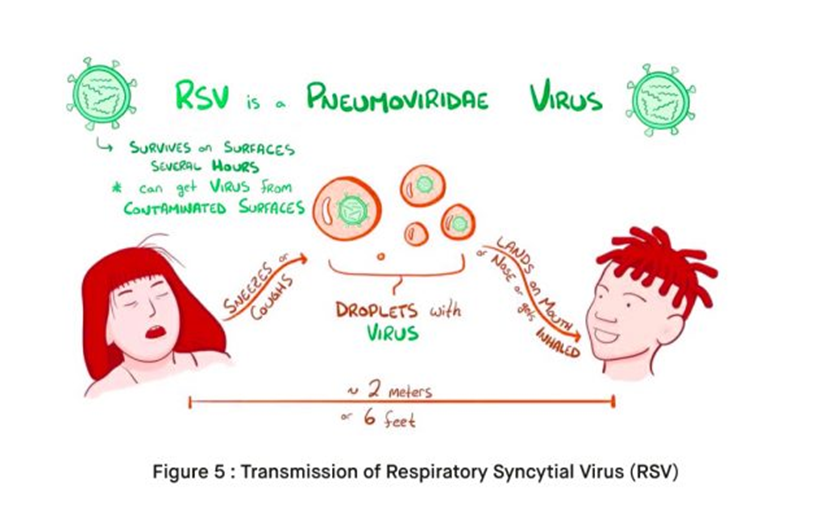A nurse is assisting with the admission of an infant who has respiratory syncytial virus (RSV), which of the following rooms should the nurse assign the infant?
A room with a toddler who has pneumonia
A private room with reverse isolation
A private room with contact/droplet precautions
A room with an infant who has croup
The Correct Answer is C
A. A room with a toddler who has pneumonia.
This option is not ideal because both RSV and pneumonia are respiratory infections that can spread to other patients. Placing these two patients together could increase the risk of cross-infection.
B. A private room with reverse isolation.
Reverse isolation is typically used to protect immunocompromised patients from acquiring infections from others. However, in the case of RSV, reverse isolation is not necessary because RSV primarily affects infants and young children who are generally not immunocompromised. Therefore, this option is not appropriate for an infant with RSV.
C. A private room with contact/droplet precautions.
This option is the most appropriate. RSV is primarily spread through respiratory droplets and direct contact with respiratory secretions. Placing the infant in a private room with contact/droplet precautions helps to minimize the risk of transmission to other patients. Healthcare workers and visitors entering the room should adhere to appropriate precautions, including wearing personal protective equipment (PPE) such as masks, gloves, and gowns.
D. A room with an infant who has croup.
Placing an infant with RSV in the same room as an infant with croup is not ideal because both conditions involve respiratory symptoms and may increase the risk of cross-infection.

Nursing Test Bank
Naxlex Comprehensive Predictor Exams
Related Questions
Correct Answer is ["B","C"]
Explanation
A. "You should begin to manipulate the infant's bedtime based on the hospital's visiting hours."
This statement is incorrect. Manipulating the infant's bedtime based on hospital visiting hours may disrupt the infant's regular sleep schedule, potentially causing discomfort and distress. It's important to maintain the infant's routine as much as possible to promote comfort and well-being.
B. "You should bring the infant's favorite blanket to the hospital."
This statement is correct. Bringing the infant's favorite blanket or comfort item can provide familiarity and comfort during the hospital stay. Having familiar items from home can help soothe the infant and reduce anxiety associated with the new environment.
C. "You should read the child a story about hospitalization."
This statement is correct. Reading a story about hospitalization to the child can help prepare them for the upcoming experience and alleviate fear or anxiety. Choosing age-appropriate books that explain what to expect during a hospital stay can help normalize the experience and provide reassurance to the infant and parents.
D. "You will need to go home when it is not visiting hours."
This statement is incorrect. Parents are typically allowed to stay with their infant throughout the hospitalization, especially in the case of pediatric patients. Family presence is important for providing comfort and support to the infant and facilitating bonding during the hospital stay.
Correct Answer is A
Explanation
A. Drink eight glasses of fluid daily: This is crucial advice for patients with sickle cell anemia, as adequate hydration helps prevent sickling of red blood cells and reduces the risk of vaso-occlusive crises. Therefore, this precaution is appropriate and should be included in discharge teaching.
B. Maintain an updated Haemophilus influenzae type b (Hib) immunization: While vaccination is essential for overall health, maintaining Hib immunization is not directly related to sickle cell anemia or vaso-occlusive crises. However, it's still important for the child's general well-being and should be addressed but may not be the priority in discharge teaching for sickle cell anemia.
C. Avoid playground activities at school: Children with sickle cell anemia are at risk of vaso-occlusive crises triggered by dehydration, fatigue, or extreme physical exertion. While playground activities can be strenuous, completely avoiding them may not be necessary. Instead, the child should be educated on the importance of staying hydrated, taking breaks when needed, and avoiding excessive physical strain.
D. Assume postural drainage positions every 6 hours: Postural drainage is not typically indicated for sickle cell anemia or vaso-occlusive crises unless there are specific respiratory complications. This precaution is not relevant to the management of sickle cell anemia and should not be included in discharge teaching for this condition.
Whether you are a student looking to ace your exams or a practicing nurse seeking to enhance your expertise , our nursing education contents will empower you with the confidence and competence to make a difference in the lives of patients and become a respected leader in the healthcare field.
Visit Naxlex, invest in your future and unlock endless possibilities with our unparalleled nursing education contents today
Report Wrong Answer on the Current Question
Do you disagree with the answer? If yes, what is your expected answer? Explain.
Kindly be descriptive with the issue you are facing.
